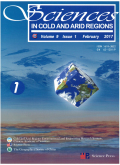- 钛学术文献服务平台 \
- 学术期刊 \
- 基础科学期刊 \
- 天文学、地球科学期刊 \
- 寒旱区科学(英文版)期刊 \
A review of the interaction between the cryosphere and atmosphere
A review of the interaction between the cryosphere and atmosphere
基本信息来源于合作网站,原文需代理用户跳转至来源网站获取
摘要:
The interaction between the cryosphere and atmosphere is an essential and extremely sensitive mutual action process on the earth. Due to global warming and the cryospheric melting, more and more attention has been paid to the interaction process between the cryosphere and atmosphere, especially the feedback of the cryosphere change to the atmosphere. A comprehensive review of the studies on the interaction between the cryosphere and atmosphere is conducted from two as-pects:(1) effects of climate change on the cryosphere or responses of the cryosphere to climate change;and (2) feedback of the cryosphere change to the climate. The response of the cryosphere to climate change is lagging. Such a lagging and cumulative effect of temperature rise within the cryosphere have resulted in a rapid change in the cryosphere in the 21st century, and its impacts have become more significant. The feedback from cryosphere change on the climate are omnifari-ous. Among them, the effects of sea ice loss and snow cover change, especially the Arctic sea ice loss and the Northern Hemisphere snow cover change, are the most prominent. The Arctic amplification (AA) associated with sea ice feedback is disturbing , and the feedback generated by the effect of temperature rise on snow properties in the Northern Hemisphere is also of great concern. There are growing evidence of the impact of the Arctic cryosphere melting on mid-latitude weath-er and climate. Weakened storm troughs, steered jet stream and amplified planetary waves associated with energy propaga-tion become the key to explaining the links between Arctic cryosphere change and atmospheric circulation. There is still a great deal of uncertainty about how cryosphere change affects the weather and climate through different atmospheric circu-lation processes at different spatial and temporal scales due to observation and simulation problems.

推荐文章
An experimental study of interaction between pure water and alkaline feldspar at high temperatures a
Alkaline feldspar
Autoclave
High-temperature and high-pressure experiments
Discrimination geochemical interaction effects on mineralization at the polymetallic Glojeh deposit,
Backward Elimination
Quadratic polynomial model
Miniature-scale changes
Ordinal–disordinal interaction effect
Akima's polynomial contour map
Immobile element
Diffusion in garnet: a review
High temperature and high pressure
Diffusion
Garnet
Point defects
Limestone mechanical deformation behavior and failure mechanisms: a review
Mechanical deformation
Brittle fracture
Ductility failure
Strength criterion
内容分析
关键词云
关键词热度
相关文献总数
(/次)
(/年)
文献信息
| 篇名 | A review of the interaction between the cryosphere and atmosphere | ||
| 来源期刊 | 寒旱区科学(英文版) | 学科 | |
| 关键词 | |||
| 年,卷(期) | 2020,(6) | 所属期刊栏目 | Reviews |
| 研究方向 | 页码范围 | 329-342 | |
| 页数 | 14页 | 分类号 | |
| 字数 | 语种 | 英文 | |
| DOI | |||
五维指标
引文网络
引文网络
二级参考文献 (213)
共引文献 (41)
参考文献 (56)
节点文献
引证文献 (0)
同被引文献 (0)
二级引证文献 (0)
1983(1)
- 参考文献(0)
- 二级参考文献(1)
1986(1)
- 参考文献(0)
- 二级参考文献(1)
1987(3)
- 参考文献(0)
- 二级参考文献(3)
1988(1)
- 参考文献(0)
- 二级参考文献(1)
1989(1)
- 参考文献(0)
- 二级参考文献(1)
1990(3)
- 参考文献(0)
- 二级参考文献(3)
1993(2)
- 参考文献(0)
- 二级参考文献(2)
1994(3)
- 参考文献(0)
- 二级参考文献(3)
1995(1)
- 参考文献(0)
- 二级参考文献(1)
1996(8)
- 参考文献(1)
- 二级参考文献(7)
1997(3)
- 参考文献(0)
- 二级参考文献(3)
1998(2)
- 参考文献(0)
- 二级参考文献(2)
1999(6)
- 参考文献(2)
- 二级参考文献(4)
2000(3)
- 参考文献(0)
- 二级参考文献(3)
2001(1)
- 参考文献(0)
- 二级参考文献(1)
2002(5)
- 参考文献(0)
- 二级参考文献(5)
2003(2)
- 参考文献(1)
- 二级参考文献(1)
2004(4)
- 参考文献(0)
- 二级参考文献(4)
2005(8)
- 参考文献(0)
- 二级参考文献(8)
2006(9)
- 参考文献(1)
- 二级参考文献(8)
2007(7)
- 参考文献(0)
- 二级参考文献(7)
2008(7)
- 参考文献(0)
- 二级参考文献(7)
2009(14)
- 参考文献(0)
- 二级参考文献(14)
2010(16)
- 参考文献(2)
- 二级参考文献(14)
2011(22)
- 参考文献(6)
- 二级参考文献(16)
2012(26)
- 参考文献(4)
- 二级参考文献(22)
2013(23)
- 参考文献(2)
- 二级参考文献(21)
2014(24)
- 参考文献(1)
- 二级参考文献(23)
2015(24)
- 参考文献(9)
- 二级参考文献(15)
2016(15)
- 参考文献(7)
- 二级参考文献(8)
2017(8)
- 参考文献(5)
- 二级参考文献(3)
2018(4)
- 参考文献(3)
- 二级参考文献(1)
2019(8)
- 参考文献(8)
- 二级参考文献(0)
2020(4)
- 参考文献(4)
- 二级参考文献(0)
2020(4)
- 参考文献(4)
- 二级参考文献(0)
- 引证文献(0)
- 二级引证文献(0)
引文网络交叉学科
相关学者/机构
期刊影响力
寒旱区科学(英文版)
主办单位:
中国科学院寒区旱区环境与工程研究所
科学出版社有限责任公司
出版周期:
双月刊
ISSN:
1674-3822
CN:
62-1201/P
开本:
出版地:
甘肃省兰州市东岗西路320号
邮发代号:
创刊时间:
语种:
eng
出版文献量(篇)
870
总下载数(次)
0
总被引数(次)
1072
期刊文献
相关文献
推荐文献
- 期刊分类
- 期刊(年)
- 期刊(期)
- 期刊推荐
力学
化学
地球物理学
地质学
基础科学综合
大学学报
天文学
天文学、地球科学
数学
气象学
海洋学
物理学
生物学
生物科学
自然地理学和测绘学
自然科学总论
自然科学理论与方法
资源科学
非线性科学与系统科学
寒旱区科学(英文版)2022
寒旱区科学(英文版)2021
寒旱区科学(英文版)2020
寒旱区科学(英文版)2019
寒旱区科学(英文版)2018
寒旱区科学(英文版)2017
寒旱区科学(英文版)2016
寒旱区科学(英文版)2015
寒旱区科学(英文版)2014
寒旱区科学(英文版)2013
寒旱区科学(英文版)2012
寒旱区科学(英文版)2011
寒旱区科学(英文版)2010
寒旱区科学(英文版)2009
寒旱区科学(英文版)2008
寒旱区科学(英文版)2020年第6期
寒旱区科学(英文版)2020年第5期
寒旱区科学(英文版)2020年第4期
寒旱区科学(英文版)2020年第3期
寒旱区科学(英文版)2020年第2期
寒旱区科学(英文版)2020年第1期

 免费查重
免费查重










